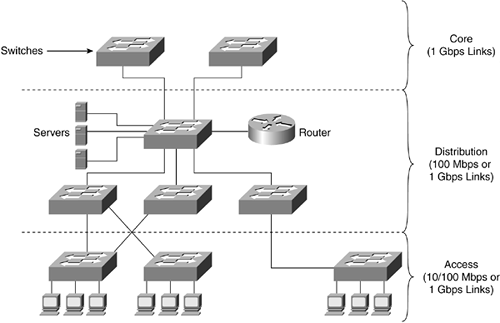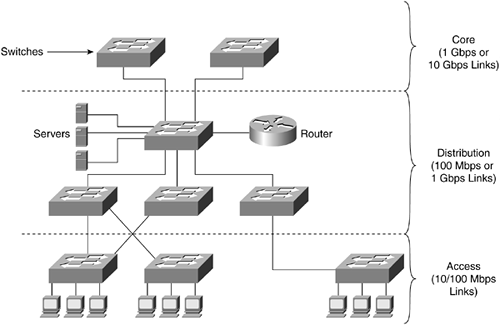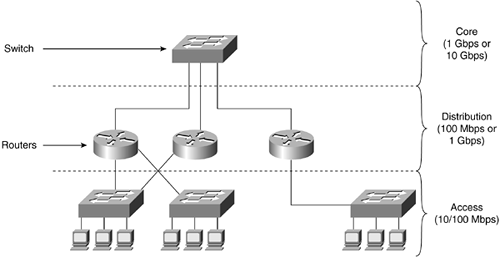Switched LAN Network Design Principles
When designing switched LAN campus networks, the following factors must be considered:
Broadcast storms? Broadcast storms can be fatal to a network. When nearly 100 percent of host CPU cycles on a device, such as a switch or users computer, are consumed by processing broadcast and multicast packets, the network is crippled and unusable. Because of delays inherent in carrier sense multiple access collision detect (CSMA/CD) technologies, such as Ethernet, any more than a small amount of broadcast traffic impacts the operation of devices attached to a switch. Although VLANs reduce the effect of broadcast radiation in LANs, there is still a scaling issue as to how many hosts should reside within a given VLAN. A router provides for larger network designs because a VLAN can be segmented depending on traffic patterns within the VLAN. In a network design where traffic is not logically segmented, however, a single router can be burdened with large amounts of traffic where the destination LAN is the same as the origination LAN.
Well-behaved VLANs? A well-behaved VLAN is not just a VLAN that behaves itself when company is visiting the parents, but it once meant a VLAN in which 80 percent or more of the traffic is local to that VLAN. The 80 percent rule is violated when a user in one VLAN reads mail from a second VLAN, reads and writes to file servers from a third VLAN, and sends print jobs to network printers in a fourth VLAN. In current network environments the 80/20 rule has given way to the implementation of server farms, which are a collection of application servers in a network-centric location. The 80/20 rule carried more weight back in the days of slower network connections than what are available today. When you had 10 Mbps available to you for user data, for example, you tried to keep as much local traffic off the line as you could. In today's environment of 100-Mbps and 1-Gbps network links, however, there is often enough available bandwidth that the 80/20 rule has lost its usefulness in network design.
Available bandwidth supporting routing functions? Inter-VLAN traffic must be routed. The network design needs to account for this traffic and allocate enough bandwidth to move inter-VLAN traffic from the source, through the router, to the destination. The amount of bandwidth used between switches needs to be monitored to ensure there is adequate trunk bandwidth between switches. EtherChannel provides incremental trunk speeds between Fast Ethernet, Gigabit Ethernet, and 10Gigabit Ethernet by combining multiple Fast Ethernet up to 800 Mbps, Gigabit Ethernet up to 8 Gbps, and 10 Gigabit Ethernet up to 80 Gbps.
Appropriate placement of administrative boundaries? Switching flattens networks. The deployment of switches outside of your administrative boundary can impact the network within your administrative boundary. If this is the case, your network traffic will be traveling across other networks, essentially trying to find its way on its own rather than being directed by your switches.
Network designs are evolving with the deployment of switching from the user desktop to the network backbone. Three topologies have emerged as generic, switched campus network designs:
Scalable switching
Large switching/minimal routing
Distributed routing/switching
Scalable Switching
A scalable switched network deploys switching at all hierarchical layers (core, distribution, and access) of the network without the use of routers. In this design, each layer consists of switches, with the devices in the access layer providing slower-speed connection to end users. A scalable switching design is illustrated in Figure 10-15.
Figure 10-15. Scalable Switch Design

A scalable switch network design is a low-cost and easy-to-install solution for a small campus network. This design does not require knowledge of network address structure, is easy to manage, and enables all users to communicate with one another.
However, you do need to remember that a scalable switch network makes up a single broadcast domain, which can lead to network congestion if the amount of broadcasts increases, such as with additional users being added to the network. If a scaled switched network needs to grow beyond the broadcast domain, then VLANs should be used to create multiple smaller broadcast domains.
note
When VLANs are used, end users in one VLAN cannot communicate with end users in another VLAN unless routers are deployed within the network to enable this inter-VLAN communication. |
Large Switched/Minimal Routing
The large switched/minimal routing design deploys switching at the access, distribution, and core layers of the network, as illustrated in Figure 10-16.
Figure 10-16. Large Switched Network with Minimal Routing

In the case of LAN switching in the distribution layer, the following issues need to be considered when designing your network:
Support for VLAN trunking technology in each enterprise-class LAN switch you use in the network. (Remember, some low-end switches do not support VLAN trunking.)
The switches in the distribution layer must run the Spanning Tree Protocol (STP) to prevent network loops. Running STP means that some connections will be blocked and load sharing will not be available for you to use in your network. However, you can load balance by having some VLANs block on one port and other VLANs block on the other port when using trunking.
If you want to scale the large switched with minimal routing network design, you must use a logical hierarchy. The logical hierarchy is made up of VLANs and routers enabling communication between the VLANs. In this topology, routing is used only in the distribution layer, and the access layer depends on bandwidth through the distribution layer to gain access to high-speed switching functionality in the core layer. The large switched/minimal routing design scales well when VLANs are used such that the majority of resources are available in the VLAN. If this topology can be designed so that 80 percent of traffic is inside the VLAN and 20 percent of traffic is external to the VLAN, the bandwidth needed for communication between VLANs is not a concern. If there is more than 20 percent communication required between VLANs, however, access to routing or Layer 3 switching in the core becomes a scalability issue, at which point you should take another look at how your VLANs are designed, possibly segmenting the VLANs even further or regrouping your users and servers.
Distributed Routing/Switching
The distributed routing/switching design uses switching in the access layer, routing in the distribution layer, and high-speed switching in the core layer, as shown in Figure 10-17.
Figure 10-17. Distributed Routing and Switching Design

The distributed routing/switching design follows the classic hierarchical network model in both physical and logical fashions. Because this design provides high bandwidth for access to routing functionality, the distributed routing and switching design scales very well. This design is ideal for networks that do not have the 80/20 rule consideration, such as a server farm implementation.






